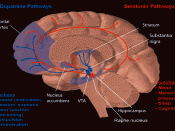Bulimia nervosa, better known as bulimia, is most common among female adolescents through their mid-twenties. Families with a history of mental health problems, eating disorders, physical illness, or substance abuse are more likely to produce people who become bulimic in their adolescent years.
They often binge by eating large amounts, up to 55, 000 calories; and then purge by inducing vomiting or misusing laxatives and diuretics or other medications that prevent their bodies from retaining all the food consumed. Bulimics repeat this binge-purge cycle from once a week to many times a day. Most often the cycle is done in secret. Bulimia may also be used in conjunction with anorexia nervosa, where the sufferer undergoes a binge-purge cycle followed by a session of anorexia nervosa, where the sufferer may over exercise and refuse to eat. Most bulimics have a normal bodyweight and appear to be healthy.
Although the causes of bulimia remain to be unknown, many believe it is triggered by a pathological fear of becoming fat.
Cultural and social ideals, low self-esteem, and the persons feelings are all thought to be factors for the cause of bulimia. Bouts of depression, boredom, and anger increase the likelihood of bulimia; the risk is especially high if the person is alone.
The mental outcome of the disorder is that the majority of bulimics have problems within their family, and exhibit symptoms of depression. Up to one third have attempted suicide. In some cases, bulimia has occupied the person's life, in that all of the person's social contacts have been shunned.
There are several signs that may indicate bulimia. If there is evidence of consumption of a large amount of food in a short period of time (binge eating) and evidence of purging (such as frequent trips to the bathroom after meals, evidence...


